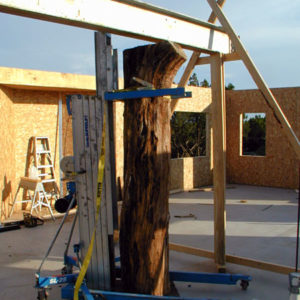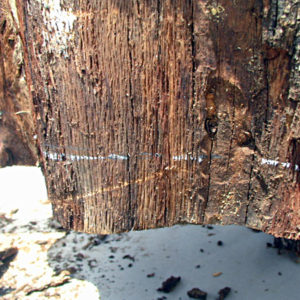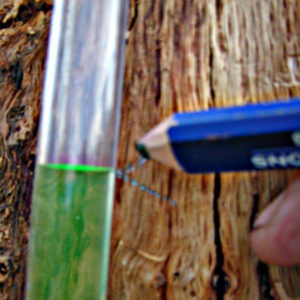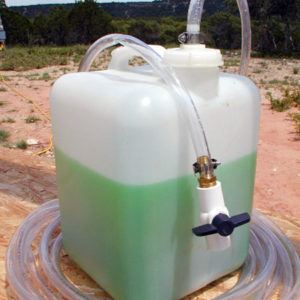Here is the water level I described on the 26th of last month in the “what tool did you buy today” thread. I had the perfect application for it this weekend. A large portion of the upstairs in our house will be supported by a steel beam resting on a 22″ diameter Red Oak tree.
I needed to cut the base of the tree level and had initially planned to rig up a router jig with a flush cut bit to level it out but I had a better idea. First I set the water level jug close to the ground and filled the tube. Then I suspended the tree from my duck jack and elevated it to where the water level was at the elevation where I wanted to cut the base and braced it level to the orientation of my eye. I then worked the level around the tree and marked a perfectly level line, laid it over on its side and fired up the chain saw.
Piece of cake! (a very heavy piece of cake mind you)
I had a plate cast into the slab with a steel pin that protrudes up into the trunk of the tree to keep it from kicking out at the base in the event someone drives a dump truck through the house and hits it with enough force to actually move it. (I estimate that it weighs at least 800 pounds – just a touch over my best bench press) I will also bolt it to the slab with a steel angle bracket on the side where the wet bar attaches to the tree.
Once I had the tree set over 2 layers of felt in its final location I marked another level line up near the top that corresponded with a water leveled mark on the wall at the other end of the beam. With those two marks I was able to shim the beam perfectly level with ease.
Viola! Not bad for a box full of plastic parts that cost me less than twenty bucks. The solution is a gallon of antifreeze mixed with four gallons of distilled water. Very easy to read even in pretty dim light.
Kevin Halliburton
“I believe that architecture is a pragmatic art. To become art it must be built on a foundation of necessity.” – I.M. Pei –

























Replies
pesky forum won't let me post directly to you
i tried to rely to the thread with the tree trunk in but it seems to have disappeared!!
my question is : how does a water level like that work??
i've only seen them as a bit of tube open at both ends. am i missing something??
aleks
Good question aleks...
Basically it works exactly like a tube with water in it but the five gallon water jug allows me to have a large reservoir of water at the reference point making it a little more stable. I can't say that either way is better but I think this way is a little easier and faster because the additional reserve of water is heavy enough that it stabilizes a little more quickly. It's also easy to just set it down and take off with the other end. No worries about accidentally lifting the other end too high and dumping water out of the reference end. I can dump the entire contents of the tube right back into the reservoir and there is no danger of spilling any of it.
One important point - in addition to opening the valve on the end of the tubing the reservoir must be vented or it will render the readings inaccurate. Here is a photo of the setup in action.
Kevin Halliburton
"I believe that architecture is a pragmatic art. To become art it must be built on a foundation of necessity." - I.M. Pei -
So I take it that the jug is vented via that little hole through the top that also has a level indicating line?
If you were going to use this to set batter boards, you would put the reference jug at one corner...probably the highest point...take off with the tube with the valve closed, then go to another corner, open the valve and let water come through the tube until it stops at level, then make the mark on the batter stake...right?
Then woudn't you also have to go back to the first corner to mark the level of the liquid in the jug on the first batter stake? Because it would be lower on account of some of the water flowing into the tube. Or since the tube contains a known amount of liquid, I suppose after the first set, you would always have a static reference line on the jug, and you could shim it up to where you wanted the original mark on the first batter stake to be. But then you would have to be careful to not let any water drain out, thus changing your reference level.
Do I have this right? (Sorry for thinking with my fingers)
You got it. I suppose you could go to the trouble of shimming the jug to the specific elevation you want to mark everywhere but all I do is set the jug at a comfortable eye level in a central location, open the vent and the valve as I'm standing right there next to the jug, let it level off and then mark that level at all of my points.
I then either string or snap a line from point to point and measure up to the specific elevation I want from there. This also leaves you with a nice level line to check your other levels against.
It's not rocket science, in fact it's been around at least since the pyramids were built, but it's still as accurate as anything made. Especially when you have to mark around corners and other obstructions where a laser would have to be reset to the same precise elevation repeatedly. (like the tree for example)
It is slow - you have to wait a good 20 seconds just about every time you move the tube for it to re-stabilize before you mark anything but it's certainly an affordable alternative to some of the more elaborate solutions. For the work alone types - The jug style level allows one guy go to town without another body to hold the other end of the tube too.
It's still a good idea to go back and check your original mark from time to time as you work your way around. If you are working in hot sun the pressure can build up in the jug or the water can expand/contract and throw you off.
If you pull it out of an air conditioned truck or a 120 degree shed it's a good idea to let it acclimate to the temperature you will be measuring in for a good half hour before you start to work. Again, by having a larger body of water in the jug these factors are a little more stable than when you are working with just a small tube full of liquid but by the same token they can create a much greater variance since there is more water to expand as it is heated if you don't let it acclimate first.
You also have to watch for large air bubbles in the line but I used 5/8" O.D. 1/2" I.D. tubing and I haven't had a bit of trouble removing air from the lines. If I had it to do over again I would have bought another ten feet of tubing. Forty feet is just barely enough to pick up all the corners on my house with the jug sitting in the center.Kevin Halliburton
"I believe that architecture is a pragmatic art. To become art it must be built on a foundation of necessity." - I.M. Pei -
If you are working in hot sun the pressure can build up in the jug or the water can expand/contract and throw you off.
But wouldn't the vent in the jug take care of that?
I'm working on a site where nothing is level, and several retaining walls will need to go in. This will also help me make some pre-plan specifications. Meeting with draftsman and framer this Saturday. DW will be there as well. It will be helpful to have some stakes marked level as we finalize the first draft.
Thanks for your updates and fine pictures. The tree idea is great. I've got a cherry tree with bark stripped running up through the middle of my cabin-soon-to-be-living-room. It provides middle support for the ridge board and also is one corner support for a sleeping loft. Held at the bottom with a bolt up through the sub-floor. The sole collar tie is another cherry log.
I don't know why you bother the tubing, worrying about air bubbles, etc, etc.
There is a lot easier way to do this.
http://www.cambridge2000.com/cam_flood/0102/images/P2063179.jpg
LOL! Yea, that's about how the Egyptian's did it. Did I mention that I live in Central, drought stricken Texas? The nearest water level that size would have taken a lot more than forty feet of tubing.Kevin Halliburton
"I believe that architecture is a pragmatic art. To become art it must be built on a foundation of necessity." - I.M. Pei -
O.K. - You guys can't tell DW I said this, but..........
A couple of days ago I was watching Hometime while DW was gone. I'm not allowed to watch shows like that because I criticize them too much........(-:
One of them was using some sort of a variation on a water level that I've never seen before. There was a "base unit" that was about 18" square that he set on the ground. And a hose went to an electronic box on a metal pole that was about 3' tall.
He set the pole thingy on the gound and zeroed it. Then he moved it around and said it was telling him how much he was above or below the first point.
Looked pretty cool. But I've never seen or heard of anything like it, and can't find anything on the internet. Don't really know what to call it.
Anybody else work with one of these? Looks like it would be awfully handy for doing grade work around a house.I'm trying to imagine you with a personality.
Never seen it but could you adapt my water level to do the same thing? Attach the loose end of the hose to a stick, mark a line on the stick at the initial reference point water level then walk around and set the base of the stick at various points and measure the distance from the water level there either up or down to your line. I'm sure it would be slower but plenty accurate. Could be faster if you attached the tube to a yard stick with the gradients already marked on it.Kevin Halliburton
"I believe that architecture is a pragmatic art. To become art it must be built on a foundation of necessity." - I.M. Pei -
Well, sure that would work.
But this was a fancy electronic gizmo. I'm a sucker for those. Why do it the simple way when you can buy an expensive toy that does the same thing ???I watch the harvest... learning from the earth of what it is to give and give again, and only in that giving to grow whole.
LOL! Heard that!!!Kevin Halliburton
"I believe that architecture is a pragmatic art. To become art it must be built on a foundation of necessity." - I.M. Pei -
If I remember right it made by a company called Zircon . they have been around for more than twenty years.
Is this i;
http://www.vci.net/waterlevel/
I use this for the google - electronic readout water level
BTW, I found these distributors that seemed to have some other interesting equipment.
http://www.perfectaline.com/index.htm
http://www.matjack.com/index.htm
I see that Zircon has improved there electronic water level. It now has a multi level signal so that it is easier (according to Zircon) to find the level. I have the older one. But the tubing is too small and it takes to long to settle. The next time I use it I am going to splice in some bigger tubing.
I tried a Zircon "buzzer" style water level a while back. Frankly, it was the most useless tool I've ever tried to work with. I found that I had about a one inch varience as to where the buzzer would go off depending on whether I snuck up on it fraction by agonizing fraction from above or below the level line. I had more accurate results with a line level on a string!
Then again, maybe I'm just too impatient or uninformed. I borrowed it from a friend and didn't have the instructions.Kevin Halliburton
"I believe that architecture is a pragmatic art. To become art it must be built on a foundation of necessity." - I.M. Pei -
W.A.
That is why I want to replace the size of the tubbing in mine.
Also I don't know what kind of distange that the new one has but with multiple sounds it seem that they have heard this complaint.
It should make it much easier to home in on the the right spot.
I have the same buzzer level and hate it.its inacurate and I can't hear the buzzer..I do love my water level however (cept when someone steps on the hose....grrrr)
a
In his first interview since the stroke, Ram Dass, 66, spoke with great difficulty about how his brush with death has changed his ideas about aging, and how the recent loss of two old friends, Timothy Leary and Allen Ginsberg, has convinced him that now, more than ever, is the time to ``Be Here Now.''
http://CLIFFORDRENOVATIONS.COM
Andy,
Your house is over 300 years old and it has a round and slanted tipi sitting by it? What possible use could you have for a level? :-)>Kevin Halliburton
"I believe that architecture is a pragmatic art. To become art it must be built on a foundation of necessity." - I.M. Pei -
Kev,
Funny you should ask.
Thats gonna be one of my biggest head scratchers on my job. Tying in. Feathering in an illusion as I've been calling it.
so why use a water level rather than a laser level is the big question to me.
I still haven't brought myself to buy one...just keep using that primitive water level. Its been tried and true all these years so......
Be on the level
andy PS.ever try it with beer and when the days over you have a really long straw.
In his first interview since the stroke, Ram Dass, 66, spoke with great difficulty about how his brush with death has changed his ideas about aging, and how the recent loss of two old friends, Timothy Leary and Allen Ginsberg, has convinced him that now, more than ever, is the time to ``Be Here Now.''
http://CLIFFORDRENOVATIONS.COM
So I take it that the jug is vented via that little hole through the top that also has a level indicating line?
I just realised that you were probably looking at the green dot and text on the handle side of the jug. That was just a sticker the water company put on the jug. It is not a level line or a vent.
It is actually vented by a little pop open lid on the the handle. You can just see the edge of it in the very first picture I posted but at the resolution of the picture you were looking at when you posted this message it doesn't really show up.
Of course, a hole anywhere above the water line would work just fine.Kevin Halliburton
"I believe that architecture is a pragmatic art. To become art it must be built on a foundation of necessity." - I.M. Pei -
Good thinking, Johnny.
But the problem can be solved with a magic marker.
Set the jug down.
Open the vent.
Take the other end of the tube to one of your batt boards.
Open the valve on the end of the tube. Rearrange the tube itself as needed, to let the water fill the tube, to a point somewhere near the end.
When it is equalized, make a mark on the tube with the magic marker, where the water is.
Make your level mark on the batt.
Walk back to the jug, move the tube around until the water levels again, at the mark on the tube, then make a mark on the side of the jug, where the water level is, there.
Now, you can take a walk around to all your other boards. Get the water in the tube to the mark again, then mark that on the batt.
The mark on the jug will be level with all the marks on the batts.
A good heart embiggins even the smallest person.
Quittin' Time
Pardon me for replying w/out scrutinizing each post, but I am fascinated w/water levels, which I first heard of in my tile-helper class. The teacher was an older guy, and had done quite a bit of high quality work w/out the advantage of the tools on the market today. Anyway, this sort of thing--using a water level--would be a wonderful tool to share w/a classroom, doncha think? Mongo? Adrian? You around?
Alright, got it...acting as HO GC will require me to set grades for the excavator (although he will also use a laser-type transit whiel he digs)...and also a hard-to- visualize retaining wall. The framer gave me measurements from known points to where the bottom of the footing needs to be...so I think I have enough constants now to set the variables.
Thanks, ALL.
This thread kind of got broken - it continues here. Let me just level with ya - the most important point in the new thread is that I was an idiot for using antifreeze. The concensus seems to be windshield washer fluid.
Of course, I knew that... I was just testing to see if anybody else did. Now why don't you go grab a tube and level something! :-)>Kevin Halliburton
"I believe that architecture is a pragmatic art. To become art it must be built on a foundation of necessity." - I.M. Pei -